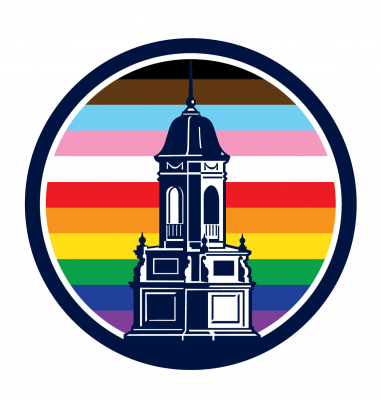Today’s post was written by Kristen Vitale, a PhD student in the UCONN History Department and one of this summer’s recipients of the EMSWG Folger travel award. We asked Kristen to answer some questions to introduce herself, which follow her post.
In August I visited the Folger for the first time to enhance my research on Tudor coronation practices. I had heard that the Library was aesthetically pleasing, but vocalized admiration and web images couldn’t prepare me for the view of the Gail Kern Paster Reading Room. The high trussed roof, embroidered wall tapestries, vintage table lamps, and the Seven Stages of Man stained glass window embodied England in early modernity and made me feel as though I was in the Tudor era.
This reaction put me in the perfect state of mind to research the plethora of Tudor revel documents that are housed at the Folger. These revels, or manuscripts pertaining to royal festivities in England, belonged namely to Sir Thomas Cawarden. He was the first man to receive the title of ‘Master‘ of Revels as an independent, official patent in 1544. To explore these manuscripts, I requested documents from the More Family of Loseley Park, which is a collection of revels from ca. 1489-1682 concerning the set up, wardrobe, styling, and stage management of royal festivities. I requested numerous manuscripts from the collection, but my focus was on one in particular: a large manuscript booklet titled, Anno Primo Edwardi vj, Revelles At The Coronacion of Edward the Sixth. The document contained the theatrical, ceremonial, and monetary details of Edward VI’s (1537 –1553) coronation.
 My excitement at discovering this manuscript was palpable. Yet, the enthusiasm that had been building since my arrival abruptly changed to dismay as I looked over the revel’s remaining eight pages. I appreciated the beauty of sixteenth century script, but it was unlike anything I had transcribed before. Following a silent thank you to the Early Modern Study Group’s transcribathons –and a lot of help from my adviser– I was able to transcribe a portion of the document. I was in awe of what I had discovered. The manuscript outlined the differing pageants that were to be performed before and during Edward VI’s coronation, portrayed the charges that were needed to move the King’s ceremonial outfits and “Masks from Warwick Inn to the late disolved house of Black friars” and detailed the appropriate ” Masks and garments for players” in the subsequent plays. In short, this Revel presented the intricate detail, specifically concerning wardrobe styling, that went in to traditional coronation processions and pageants.
My excitement at discovering this manuscript was palpable. Yet, the enthusiasm that had been building since my arrival abruptly changed to dismay as I looked over the revel’s remaining eight pages. I appreciated the beauty of sixteenth century script, but it was unlike anything I had transcribed before. Following a silent thank you to the Early Modern Study Group’s transcribathons –and a lot of help from my adviser– I was able to transcribe a portion of the document. I was in awe of what I had discovered. The manuscript outlined the differing pageants that were to be performed before and during Edward VI’s coronation, portrayed the charges that were needed to move the King’s ceremonial outfits and “Masks from Warwick Inn to the late disolved house of Black friars” and detailed the appropriate ” Masks and garments for players” in the subsequent plays. In short, this Revel presented the intricate detail, specifically concerning wardrobe styling, that went in to traditional coronation processions and pageants.
While the Edward VI revel was certainly enough to keep my attention, there were other notable manuscripts that I discovered during my stay. For instance, one document, written during the reign of King Henry VIII (1491-1547) in 1539, ordered Christopher More (1483 –1549), a Member of Parliament, to proceed to London with “6 servants honestly furnished” to serve as “guard of honor” to Anne of Cleves (1515-1547) upon her arrival to England. While only a small folio, this manuscript depicted the proper attire for ceremonial wedding occasions in King Henry’s court. This specifically was an occasion that would have been followed by a coronation procession, had he not annulled the marriage five months after the vows.
My time at the Folger came to an end far too quickly. While I could spend eons describing these fascinating Tudor manuscripts, it would be thoughtless not to take a moment to praise the kind employees at the Folger. Not only were they patient and willing to answer any questions that arose during my stay, but they were also genuinely interested in my discoveries. Their supportiveness fostered a warm and intellectually stimulating research environment that I will be sure to visit in the future. Moreover, I could not have made the trip without the generous funding from the Humanities Institute’s Early Modern Studies Working Group in the form of the Folger Travel Award. I am immensely grateful to have had the opportunity to embark on such an endeavor, and am already planning my return trip to the Folger.
What are your research and teaching interests?
Research: Early Modern Europe, specifically England. Cultural and Gender History; Monarchies; Early Tudor Pageantry
Teaching: Western Traditions 1300 — love teaching surveys!
What is your current projects?
Just finished a history grad seminar project on the pageants of Anne Boleyn’s coronation procession ca. 1533.
What is your favorite thing to teach? (ex: unit, concept, text or reading, etc.)
If I am sticking with Western Traditions Hist-1300- I love teaching the Greco-Persian Wars and the Founding of the Roman Republic through the Roman Empire (emphasis on Caesar’s dictatorship) — course usually ends ca. 1492 (at least when I’ve taught it) a tad before my period.
Who is your favorite historical figure from the early modern period and why?
This is a surprisingly difficult question to answer! If I am staying in my field then Anne Boleyn. I realize Anne as a historical figure is rather streamline, but while most focus on her relationship with Henry, I find her emotional and intellectual inclinations toward humanism fascinating. As a side, I adore Matilda of Flanders.
Where are you from originally and/or where else have you taught or gone to school?
I am a native of CT. I went to Nazareth College in Rochester NY for undergrad, Providence College in Providence RI for my Masters. I’ve taught at Manchester Community College



